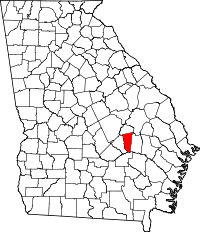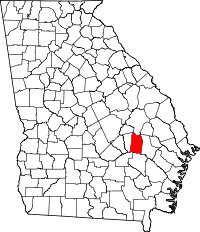Vidalia, Georgia
| City of Vidalia, Georgia | |
|---|---|
| City | |
|
Vidalia Municipal Building (City Hall) | |
| Motto: "The Sweet Onion City"[1] | |
 Location in Toombs County and the state of Georgia | |
| Coordinates: 32°12′55″N 82°24′36″W / 32.21528°N 82.41000°WCoordinates: 32°12′55″N 82°24′36″W / 32.21528°N 82.41000°W | |
| Country | United States |
| State | Georgia |
| Counties | Toombs, Montgomery |
| Area | |
| • Total | 17.4 sq mi (45.2 km2) |
| • Land | 17.3 sq mi (44.9 km2) |
| • Water | 0.1 sq mi (0.3 km2) |
| Elevation | 299 ft (91 m) |
| Population (2010) | |
| • Total | 10,473 |
| • Density | 601.9/sq mi (231.7/km2) |
| Time zone | Eastern (EST) (UTC-5) |
| • Summer (DST) | EDT (UTC-4) |
| ZIP codes | 30474-30475 |
| Area code(s) | 912 |
| FIPS code | 13-79388[2] |
| GNIS feature ID | 0324704[3] |
| Website | The City of Vidalia, Georgia |
Vidalia (/vaɪˈdeɪljə/ vye-DAYL-yə or local /vaɪˈdeɪjə/ vye-DAY-yə) is a city located primarily in Toombs County, Georgia, United States. The city also extends very slightly into Montgomery County.[4] As of the 2010 census, the city population was 10,473.
Vidalia is the principal city of the Vidalia Micropolitan Statistical Area, a micropolitan area that covers Montgomery and Toombs Counties,[5] and had a combined population of 36,346 at the 2010 census.[2]
Description and history
The town was incorporated on January 1, 1890.[6] It is the largest city in Toombs County, but it is not the county seat.[7] Although a Georgia website suggests the town may have been named "via dalia" ("road of dahlias"),[6] it may have been named — like Vidalia, Louisiana — in honor of Don José Vidal, a Spanish aristocrat.
Like many towns in the region, Vidalia grew up around a rail yard that served farmers in the area who grew such crops as pecans and tobacco. The area's famous onions[8] were not an important crop until much later.
In the 1950s, Piggly Wiggly grocery stores opened a distribution center in Vidalia, bringing with it a large influx of jobs as well as railroad business. At that time, Vidalia served as an interchange junction between the Central of Georgia and the Georgia and Florida (later both Southern railroads). For this, a large seven track yard was constructed, as well as a sizable engine servicing facility and interchange yard. The latter, smaller interchange yard is still in use to some degree by the Georgia Central railroad, while the larger yard was removed sometime in the 1970s. Dot Foods currently occupies most of the old Piggly Wiggly distribution center, with smaller companies leasing space.
Currently, the largest employers in Vidalia are Trane who has a large assembly plant and Wal-Mart which is rumored to be located on the former farm where the Vidalia sweet onions were first grown.
Geography
According to the United States Census Bureau, the city has a total area of 17.4 square miles (45 km2), of which 17.3 square miles (45 km2) is land and 0.1 square miles (0.26 km2) (0.63%) is water. Vidalia is located at 32°12′55″N 82°24′36″W / 32.21528°N 82.41000°W (32.215305, -82.410086).[9]
Demographics
| Historical population | |||
|---|---|---|---|
| Census | Pop. | %± | |
| 1900 | 503 | — | |
| 1910 | 1,776 | 253.1% | |
| 1920 | 2,860 | 61.0% | |
| 1930 | 3,585 | 25.3% | |
| 1940 | 4,109 | 14.6% | |
| 1950 | 5,819 | 41.6% | |
| 1960 | 7,569 | 30.1% | |
| 1970 | 9,507 | 25.6% | |
| 1980 | 10,393 | 9.3% | |
| 1990 | 11,078 | 6.6% | |
| 2000 | 10,491 | −5.3% | |
| 2010 | 10,473 | −0.2% | |
| Est. 2015 | 10,679 | [10] | 2.0% |
As of the census[2] of 2000, there were 10,491 people, 4,167 households, and 2,758 families residing in the city; of these, 160 people lived in Montgomery and the rest in Toombs counties. The population density was 605.4 people per square mile (233.7/km²). There were 4,676 housing units at an average density of 269.8 per square mile (104.2/km²). The racial makeup of the city was 59.61% White, 36.88% African American, 0.89% Asian, 0.14% Native American, 1.82% from other races, and 0.66% from two or more races. Hispanic or Latino of any race were 3.24% of the population.
There were 4,167 households out of which 32.4% had children under the age of 18 living with them, 43.7% were married couples living together, 18.5% had a female householder with no husband present, and 33.8% were non-families. 30.5% of all households were made up of individuals and 12.7% had someone living alone who was 65 years of age or older. The average household size was 2.46 and the average family size was 3.06.
In the city the population was spread out with 27.9% under the age of 18, 8.5% from 18 to 24, 26.5% from 25 to 44, 22.2% from 45 to 64, and 14.8% who were 65 years of age or older. The median age was 36 years. For every 100 females there were 81.4 males. For every 100 females age 18 and over, there were 76.6 males.
The median income for a household in the city was $28,365, and the median income for a family was $40,091. Males had a median income of $30,180 versus $18,496 for females. The per capita income for the city was $16,369. About 15.4% of families and 19.9% of the population were below the poverty line, including 29.5% of those under age 18 and 18.8% of those age 65 or over.
Economy
Vidalia has a mixed economy, but its largest industry is agriculture. Since 1931, Granex onions grown in and near Vidalia have been licensed and sold internationally as Vidalia onions. In 1986, the Vidalia Onion Trademark Act granted a state trademark and protection on the onions of the Vidalia and Toombs County area. The 1989 Federal Marketing Order #955 of the USDA Agricultural Marketing Service gave the growers and handlers the legal rights to establish the Vidalia Onion Committee, and it granted U.S. federal protection of the onion's name and production.
Onions
Vidalia is best known for its "sweet" onions. The Vidalia onion was first produced about 1931 when a farmer named Mose Coleman discovered that the onions he produced were sweeter than other onions. Other farmers started growing the same crop, and in the 1940s the Vidalia onion became an item sold to tourists.
Vidalia onion growers have protected their brand, and today all onions labelled Vidalia must be grown in one of thirteen different counties in Georgia or in specific portions of seven other counties. Because of their taste and reputation, they are able to command an increased price in the marketplace.
In 1990, the Vidalia onion was named as the official vegetable of the state of Georgia.
Year 2000 production was estimated at 40,000,000 fifty-pound (22.68 kg) bags.
(See: Vidalia Onion and Protection as a Geographic Indication)
Arts and culture
Annual cultural events
Each spring Vidalia holds a world-famous Onion Festival. The event lasts for five days and draws in many tourists with its wide variety of activities.[12]
Museums and other points of interest
The Altama Gallery is a museum of history and art located inside the restored Brazell House.[7]
Education
Public schools
Vidalia Public Schools are part of the Vidalia City School District. The school district holds pre-school to grade twelve, and consists of two elementary schools, a middle school, and a high school.[13] The district has 144 full-time teachers and over 2,408 students.[14]
- J.D. Dickerson Primary School
- Sally Dailey Meadows Elementary School
- J.R. Trippe Middle School
- Vidalia Comprehensive High School
- Edward D Phillips Special Education Center.
Notable people
- Mel Blount, former Pittsburgh Steelers defensive back, five-time pro bowler and Pro Football Hall of Fame inductee; born in Vidalia[15]
- Paul Claxton, American professional golfer; born in Vidalia[16]
- Don Harris, NBC News correspondent who was killed during the Jonestown Massacre; born in Vidalia
- Algur H. Meadows, oilman, art collector, and benefactor of Southern Methodist University and other institutions; born in Vidalia
- Wallace Moses, former American baseball player
- Carl Simpson, former American football player; born in Vidalia[17]
- Fred Stokes, former American football defensive end who played ten seasons in the National Football League; born in Vidalia[18]
Vidalia in music
Although it has never been officially confirmed, it is believed by locals that the 1996 song Vidalia sung by Sammy Kershaw alludes to the Vidalia Sweet Onion crop with its lyrics "...sweet Vidalia, You always gotta make me cry!" While uncertainty remains about the song, Vidalia sweet onions have recently made a name for the town through national media and the Onions and Ogres advertisement campaign which features the cartoon ogre Shrek.
References
- ↑ "The City of Vidalia, Georgia". The City of Vidalia, Georgia. Retrieved September 5, 2012.
- 1 2 3 "American FactFinder". United States Census Bureau. Archived from the original on September 11, 2013. Retrieved 2008-01-31.
- ↑ "US Board on Geographic Names". United States Geological Survey. 2007-10-25. Retrieved 2008-01-31.
- ↑ "Profile for Vidalia, Georgia, GA". ePodunk. Retrieved September 5, 2012.
- ↑ MICROPOLITAN STATISTICAL AREAS AND COMPONENTS , Office of Management and Budget, 2007-05-11. Accessed 2008-07-27.
- 1 2 "Vidalia". Georgia.gov. Retrieved September 5, 2012.
- 1 2 "Vidalia". Georgia Department of Community Affairs. Retrieved September 5, 2012.
- ↑ "About Us". VidaliaOnion.org. The Vidalia® Onion Committee. Retrieved March 17, 2016.
'Vidalia onions aren’t just the most famous onions in the world; I think they may be the only famous onions in the world.' —Chef Bobby Flay
- ↑ "US Gazetteer files: 2010, 2000, and 1990". United States Census Bureau. 2011-02-12. Retrieved 2011-04-23.
- ↑ "Annual Estimates of the Resident Population for Incorporated Places: April 1, 2010 to July 1, 2015". Retrieved July 2, 2016.
- ↑ "Census of Population and Housing". Census.gov. Archived from the original on May 11, 2015. Retrieved June 4, 2015.
- ↑ http://www.vidaliaonionfestival.com/
- ↑ Georgia Board of Education, Retrieved June 28, 2010.
- ↑ School Stats, Retrieved June 28, 2010.
- ↑ "Hall of Famers: Mel Blount". The Offiial Site of the Pro FootballHall of Fame. Retrieved September 5, 2012.
- ↑ "Paul Claxton". PA Tour, Inc. Retrieved September 5, 2012.
- ↑ "Carl Simpson". databaseFootball.com. Retrieved September 5, 2012.
- ↑ "Fred Stokes". Pro-Football-Reference.com. Retrieved September 5, 2012.
External links
| Wikimedia Commons has media related to Vidalia, Georgia. |
- Official website Portal style website, Government, Business, Library, Recreation and more
- City of Vidalia entry from the State of Georgia government portal
- Official Vidalia Department of Tourism
- The Official Vidalia Onion Website: Recipes, Information & Links
- The Wall Street Journal-The Onion's Best Friend Is an Ogre


